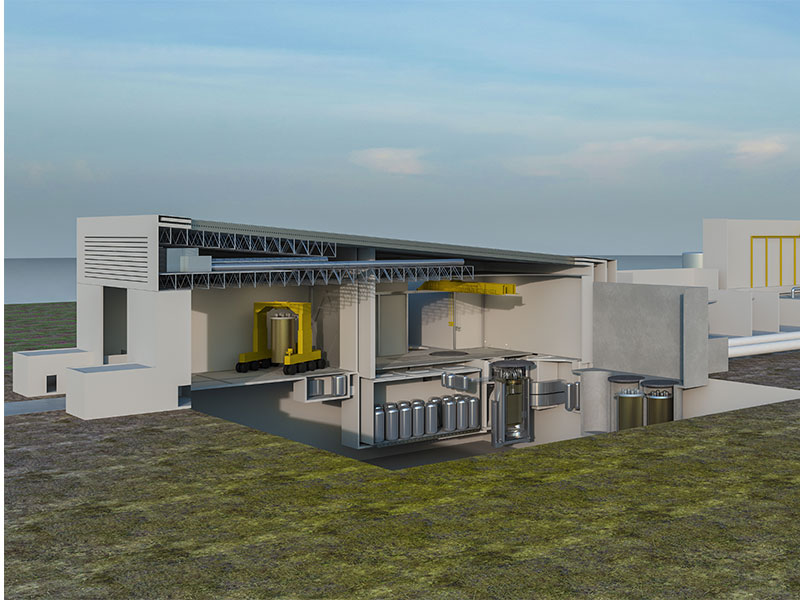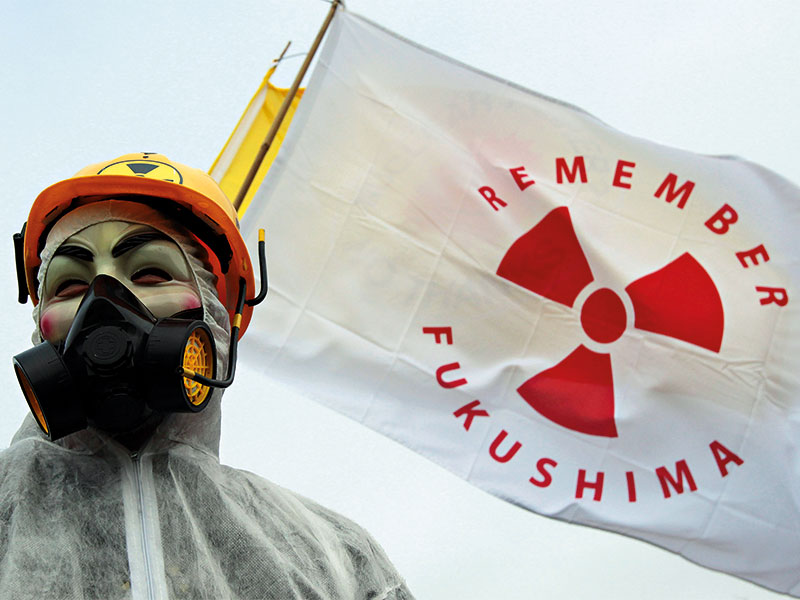The impending threat of climate change brings nuclear energy to the fore once more
Nuclear power’s image problem has stunted investment for years. Now, as the threat of climate change looms larger, cutting-edge start-ups are bringing the energy source back into the conversation

Innovative nuclear technologies could give the industry a new lease of life - but concerns about waste remain
When the Fukushima Daiichi Nuclear Power Plant went into meltdown in March 2011, the consequences stretched far beyond the surrounding evacuation zone.
In the months following the incident, many prominent politicians in Germany who had previously been supportive of nuclear energy – including Chancellor Angela Merkel – changed their position. In May 2011, the German Government announced it would shut all nuclear reactors in the country by 2022.
Events like Fukushima – and the Chernobyl disaster that occurred some 25 years earlier – hang over nuclear power like a toxic mushroom cloud, dominating public discussion.
Even as proponents talk up its benefits – chiefly, a continuous supply of cheap, low-carbon energy – they often struggle to be heard over those pointing to these disastrous events.
Today, a number of cutting-edge start-ups are trying to change this narrative. Driven by entrepreneurial passion, as well as the possibility of government subsidies and significant profits, these businesses are set to shake up an industry that has long been in need of new ideas.
The forgotten man
The environmental challenges facing our planet are well documented: average global temperatures continue to increase and sea levels are rising at rates not seen for thousands of years.
Although the majority of scientists are in agreement as to the causes of climate change, coming to a consensus on how to tackle them has not been easy. Certainly, not every expert has been brave enough to admit nuclear power should play a key role in the world’s future energy makeup.
The Paris Agreement was rightly lauded for the way it attempted to bring unity to a fractious debate, but there are no easy answers when it comes to reducing carbon emissions.
Crucially, the agreement makes just one reference to renewable energy across its 32 pages. Its technology-neutral approach is long overdue and makes nuclear power a more viable option for carbon mitigation strategies.
According to Simon Irish, CEO of Terrestrial Energy, one of a number of firms taking a novel approach to nuclear technology, this can only be a good thing for the fight against climate change.
11%
Nuclear power’s contribution to the global energy supply
“In recent decades, nuclear energy has always suffered from a negative perception,” Irish told The New Economy. “However unfair and inaccurate these views, they have held nuclear technology back from achieving [its] full potential. Attitudes in the 1990s and 2000s also held back nuclear innovation. That has now changed: the potential of advanced reactors is driving growing excitement.”
In an ideal world, power generated from solar, wind and various other forms of renewable energy would be enough to meet humanity’s needs. However, challenges concerning the reliability and storage of some renewables make this optimistic at best.
In an op-ed published by The Guardian shortly after the Paris Agreement was signed, scientists James Hansen, Kerry Emanuel, Ken Caldeira and Tom Wigley argued that dismissing nuclear energy makes it more difficult to move towards a decarbonised planet.
They wrote: “The climate issue is too important for us to delude ourselves with wishful thinking. Throwing tools such as nuclear out of the box constrains humanity’s options and makes climate mitigation more likely to fail. We urge an all-of-the-above approach that includes increased investment in renewables combined with an accelerated deployment of new nuclear reactors.”
This is not to suggest those with concerns regarding nuclear power should be ignored. According to the Guardian article, nuclear reactors have prevented approximately 60 billion tonnes of carbon dioxide from entering the atmosphere over the past 50 years – however, in its place, they have produced radioactive waste that, if improperly managed, could pose a serious threat to humans and wildlife.
When this by-product of the nuclear industry is classified as high-level waste, it must be kept isolated for thousands of years.
Old and new
Commercial nuclear power has been utilised since the 1950s, but early hopes for nuclear-powered space shuttles, artificial hearts driven by radioactive batteries and plutonium-heated swimming pools for scuba divers never came to fruition. Today, the technology only meets around 11 percent of the world’s energy needs.
While negative headlines have certainly held nuclear back, so too has a lack of technological development. This wasn’t much of a problem when conventional reactors were turning a profit, but it has recently become more challenging.
The falling cost of renewables is eroding nuclear’s competitive advantage, and the industry is struggling to find the funds to decommission older reactors, let alone build new ones.
In addition, recent failings have further undermined investor confidence in nuclear projects. Last year, South Carolina Electric & Gas confirmed it would be shelving plans to build two large nuclear reactors in Fairfield County despite having already committed $9bn to their construction.
Estimates indicate the companies involved in the project would recoup just $861m if they were to sell the unfinished reactors for parts.
And yet, the industry’s future is not entirely bleak. While conventional reactor projects continue to struggle across Europe and the US, more inventive approaches are finding favour. According to the centre-left think tank Third Way, there are now 75 advanced nuclear projects in the US alone – a significant increase from the 48 recorded in 2015. ‘Next-generation reactors’ can also be found in Russia and China.

It’s hardly surprising Irish believes it is an exciting time to be working in nuclear power: “The tremendous potential of advanced nuclear technology, encouraged by supportive industry policy in many markets, has been the business incentive for dozens of nuclear energy start-ups in the UK, Canada and the US, representing investments of over $1.5bn in private capital.”
The new developments are taking a variety of forms and have different benefits. So-called ‘fast reactors’, for example, have been trialled in a number of countries to process the nuclear waste produced by conventional reactors.
Other ideas have focused on creating small modular reactors capable of operating in places where large-scale reactors wouldn’t be feasible. The commercial viability of nuclear fusion, as opposed to fission, is also being explored. These ideas could all give the industry a new lease of life.
Worth its salt
Traditional nuclear reactors use a continuously flowing system of water to prevent overheating. When this water is disrupted – as with the Fukushima plant when the tsunami hit – the reactor quickly overheats, leading to explosions and nuclear meltdowns. Creating a new type of reactor that avoids this safety flaw is a key concern for the advanced nuclear movement.
One of the proposals currently gaining traction in the market involves the use of a molten salt reactor that automatically cools down if it starts to overheat. Terrestrial Energy is one of a number of companies exploring this technology, which is capable of creating reactors that are ‘walk-away safe’.
This means that even if plant operators turned off the safety systems and walked away, the salts would continue to cool the reactor. This is due to the fact the liquid salt expands when it is heated, pushing the uranium atoms apart and slowing the reaction.
According to Irish, there are a number of other advantages associated with this technology: “Terrestrial Energy’s advanced nuclear power plant design, called the Integral Molten Salt Reactor [IMSR], represents a transformative clean energy technology, fundamentally different from today’s commercial reactors.
“IMSR power plants are a scalable and cost-effective clean energy alternative to fossil fuel combustion. They can be built at a fraction of the upfront cost of a conventional nuclear power plant and in half the time.”
The safety benefits molten salt reactors can deliver could be worth far more than any financial savings
According to the Terrestrial Energy CEO, an IMSR power plant could generate electricity at a cost of $50/MWh, a significant reduction from the average $97/MWh delivered by conventional reactors. If achieved, this figure would also prove competitive against electricity generated by fossil fuels – particularly coal.
Although it would be easy to dismiss Terrestrial’s estimates as optimistic, technological developments could see the cost of energy generated by molten salt reactors come down further. More importantly, the safety benefits they can deliver could be worth far more than any financial savings.
Getting the green light
Nuclear power has long been overdue a revamp, but the delay is, to some extent, understandable. Time frames are always going to be stretched when the technologies involved are producing large quantities of hazardous waste.
Regulatory challenges can be particularly difficult to overcome and can leave entrepreneurs waiting decades between a project’s formulation and its commercialisation. In the US, the Nuclear Regulatory Commission has been heavily criticised for being something of a closed shop, unwilling to create relationships with the new wave of nuclear businesses.
With investors unsure as to when, or indeed if, they’ll make a financial return, nuclear start-ups face an uphill battle to acquire the funding needed to gain a foothold in a prohibitively expensive industry. In turn, this can cause nuclear start-ups to exaggerate their potential profits in order to outshine competitors.
While this may help firms plug momentary gaps in funding, it erodes long-term confidence in the industry. Still, the hurdles facing advanced nuclear start-ups are not enough to deter everyone.
“We plan for [the] first commercial deployments of IMSR power plants in the 2020s, and are making steady progress towards this goal,” Irish noted. “Any truly innovative technology takes time to develop, but our IMSR design removes many of the limitations that have held back traditional reactor designs, and has advantages even when compared to other advanced reactors.”
To back up Terrestrial’s optimism, the US Senate’s energy committee passed the Advanced Nuclear Energy Technologies Act earlier this year, authorising the secretary of energy to push ahead with four advanced nuclear reactors by 2028. However, even with the boost this will give nuclear start-ups, time may not be on their side.
In order for nuclear power to supply just a fraction of the clean energy required over the coming decades, governments around the world will need to approve new plants at a far faster rate than is currently the norm.
It will require a shift in the regulatory mindset to one that is more receptive to new ideas. In other words, government incentives for low-carbon fuels will need to encompass more than just renewables.
The potential effects of climate change will be devastating. Even if the two-degree-Celsius target set forward by the Paris Agreement is met, the most pessimistic predictions indicate that sea levels could still rise by as much as six metres by 2100.
As humanity struggles to curtail its consumption, its margin for error gets smaller and smaller. To reject nuclear power as a possible addition to our decarbonisation efforts, just as new technological advancements are gaining ground, could prove to be an incredibly short-sighted decision.













